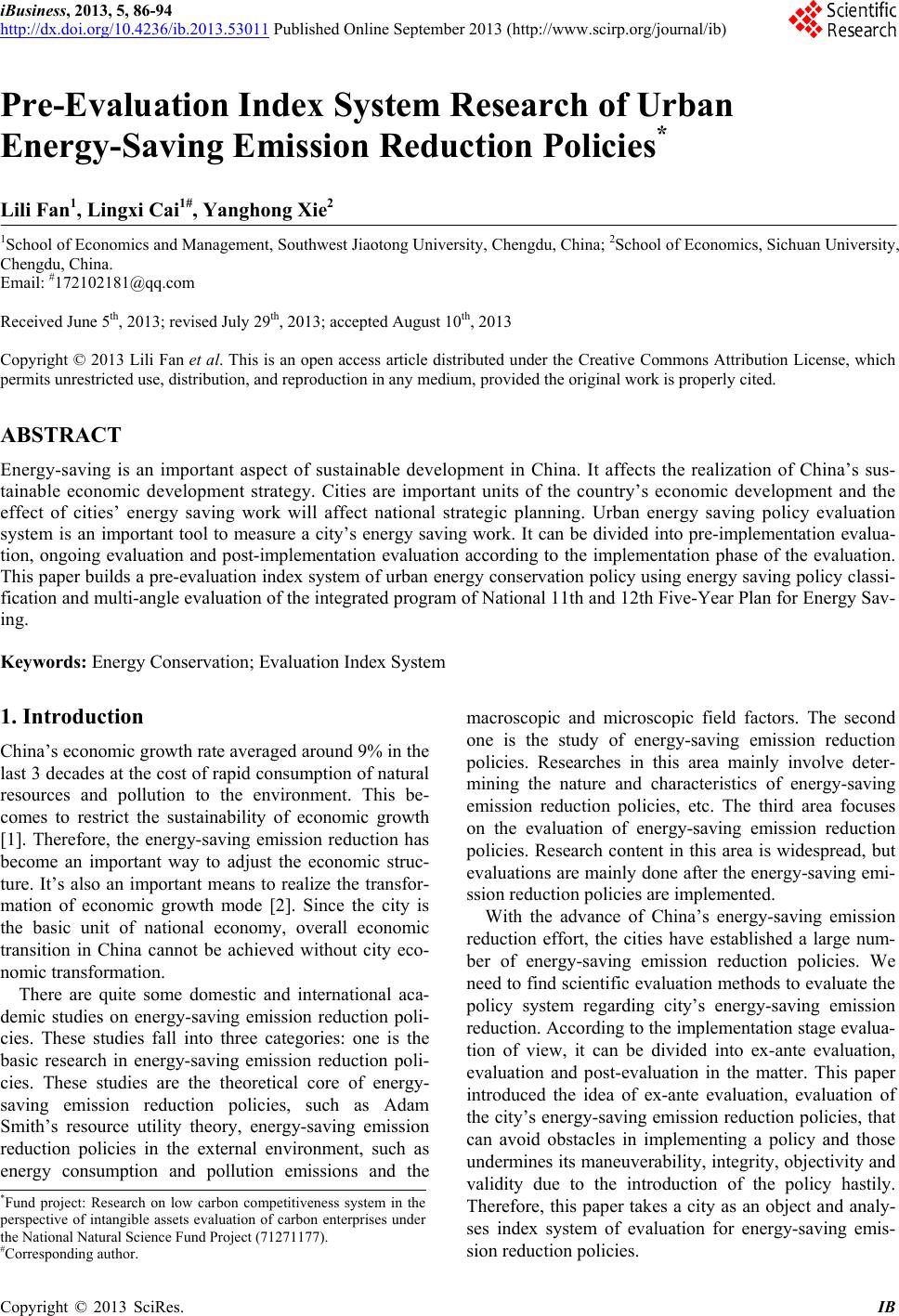 iBusiness, 2013, 5, 86-94 http://dx.doi.org/10.4236/ib.2013.53011 Published Online September 2013 (http://www.scirp.org/journal/ib) Pre-Evaluation Index System Research of Urban Energy-Saving Emission Reduction Policies* Lili Fan1, Lingxi Cai1#, Yanghong Xie2 1School of Economics and Management, Southwest Jiaotong University, Chengdu, China; 2School of Economics, Sichuan University, Chengdu, China. Email: #172102181@qq.com Received June 5th, 2013; revised July 29th, 2013; accepted August 10th, 2013 Copyright © 2013 Lili Fan et al. This is an open access article distributed under the Creative Commons Attribution License, which permits unrestricted use, distribution, and reproduction in any medium, provided the original work is properly cited. ABSTRACT Energy-saving is an important aspect of sustainable development in China. It affects the realization of China’s sus- tainable economic development strategy. Cities are important units of the country’s economic development and the effect of cities’ energy saving work will affect national strategic planning. Urban energy saving policy evaluation system is an important tool to measure a city’s energy saving work. It can be divided into pre-implementation evalua- tion, ongoing evaluation and post-implementation evaluation according to the implementation phase of the evaluation. This paper builds a pre-evaluation index system of urban energy conservation policy using energy saving policy classi- fication and multi-angle evaluatio n of the integr ated program of National 11 th and 12th Five-Year Plan for Energy Sav- ing. Keywords: Energy Conservation; Evaluation Index System 1. Introduction China’s economic growth rate av er ag ed around 9% in th e last 3 decades at the cost of rapid consumption of natural resources and pollution to the environment. This be- comes to restrict the sustainability of economic growth [1]. Therefore, the energy-saving emission reduction has become an important way to adjust the economic struc- ture. It’s also an important means to realize the transfor- mation of economic growth mode [2]. Since the city is the basic unit of national economy, overall economic transition in China cannot be achieved without city eco- nomic transformation. There are quite some domestic and international aca- demic studies on energy-saving emission reduction poli- cies. These studies fall into three categories: one is the basic research in energy-saving emission reduction poli- cies. These studies are the theoretical core of energy- saving emission reduction policies, such as Adam Smith’s resource utility theory, energy-saving emission reduction policies in the external environment, such as energy consumption and pollution emissions and the macroscopic and microscopic field factors. The second one is the study of energy-saving emission reduction policies. Researches in this area mainly involve deter- mining the nature and characteristics of energy-saving emission reduction policies, etc. The third area focuses on the evaluation of energy-saving emission reduction policies. Research content in this area is widespread, but evaluations are mainly d one after the energy-saving emi- ssion reduction policies are implemented. With the advance of China’s energy-saving emission reduction effort, the cities have established a large num- ber of energy-saving emission reduction policies. We need to find scientific evaluation methods to evaluate the policy system regarding city’s energy-saving emission reduction. According to th e implementation stag e evalu a- tion of view, it can be divided into ex-ante evaluation, evaluation and post-evaluation in the matter. This paper introduced the idea of ex-ante evaluation, evaluation of the city’s energy-saving emissio n reduction policies, that can avoid obstacles in implementing a policy and those undermines its maneuverability, integ rity, objectivity and validity due to the introduction of the policy hastily. Therefore, this paper takes a city as an object and analy- ses index system of evaluation for energy-saving emis- sion reduction policies. *Fund project: Research on low carbon competitiveness system in the erspective of intangible assets evaluation of carbon enterprises under the National Natural Science Fund Project (71271177). #Corresponding author. Copyright © 2013 SciRes. IB 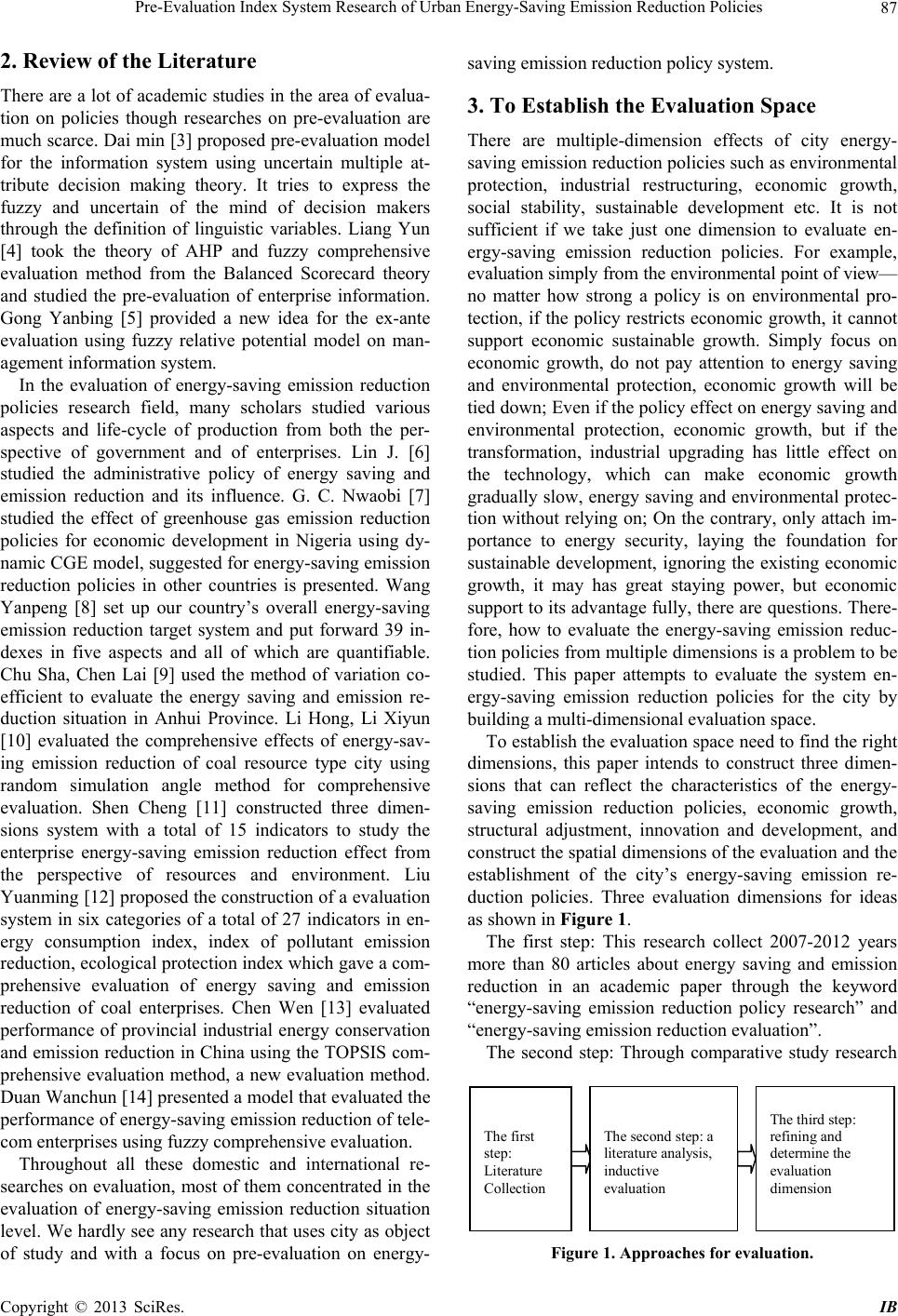 Pre-Evaluation Index System Research of Urban Energy-Saving Emission Reduction Policies 87 2. Review of the Literature There are a lot of academic studies in the area of evalua- tion on policies though researches on pre-evaluation are much scarce. Dai min [3] proposed pre-evaluation model for the information system using uncertain multiple at- tribute decision making theory. It tries to express the fuzzy and uncertain of the mind of decision makers through the definition of linguistic variables. Liang Yun [4] took the theory of AHP and fuzzy comprehensive evaluation method from the Balanced Scorecard theory and studied the pre-evaluation of enterprise information. Gong Yanbing [5] provided a new idea for the ex-ante evaluation using fuzzy relative potential model on man- agement information system. In the evaluation of energy-saving emission reduction policies research field, many scholars studied various aspects and life-cycle of production from both the per- spective of government and of enterprises. Lin J. [6] studied the administrative policy of energy saving and emission reduction and its influence. G. C. Nwaobi [7] studied the effect of greenhouse gas emission reduction policies for economic development in Nigeria using dy- namic CGE model, suggested for energy-saving emission reduction policies in other countries is presented. Wang Yanpeng [8] set up our country’s overall energy-saving emission reduction target system and put forward 39 in- dexes in five aspects and all of which are quantifiable. Chu Sha, Chen Lai [9] used the method of variation co- efficient to evaluate the energy saving and emission re- duction situation in Anhui Province. Li Hong, Li Xiyun [10] evaluated the comprehensive effects of energy-sav- ing emission reduction of coal resource type city using random simulation angle method for comprehensive evaluation. Shen Cheng [11] constructed three dimen- sions system with a total of 15 indicators to study the enterprise energy-saving emission reduction effect from the perspective of resources and environment. Liu Yuanming [12] proposed the construction of a evaluation system in six categories of a total of 27 indicators in en- ergy consumption index, index of pollutant emission reduction, ecological protection index which gave a com- prehensive evaluation of energy saving and emission reduction of coal enterprises. Chen Wen [13] evaluated performance of provincial industrial energy conservation and emission reduction in China using the TOPSIS com- prehensive evaluation method, a new evaluation method. Duan Wanchun [14] presented a model that evaluated the performance of energy-saving emission reduction of tele- com enterprises using fuzzy comprehensive evaluation. Throughout all these domestic and international re- searches on evaluation, most of them concentrated in the evaluation of energy-saving emission reduction situation level. We hardly see any research that uses city as object of study and with a focus on pre-evaluation on energy- saving emission reduction po licy sy stem. 3. To Establish the Evaluation Space There are multiple-dimension effects of city energy- saving emission reduction policies such as en vironmental protection, industrial restructuring, economic growth, social stability, sustainable development etc. It is not sufficient if we take just one dimension to evaluate en- ergy-saving emission reduction policies. For example, evaluation simply from the environmental point of view— no matter how strong a policy is on environmental pro- tection, if the policy restricts economic growth, it cannot support economic sustainable growth. Simply focus on economic growth, do not pay attention to energy saving and environmental protection, economic growth will be tied down; Even if th e policy effect on energy saving an d environmental protection, economic growth, but if the transformation, industrial upgrading has little effect on the technology, which can make economic growth gradually slow, energy saving and environmental protec- tion without relying on; On the contrary, only attach im- portance to energy security, laying the foundation for sustainable development, ignoring the existing economic growth, it may has great staying power, but economic support to its advantag e fully, there are questions. There- fore, how to evaluate the energy-saving emission reduc- tion policies from multiple d imensions is a prob lem to be studied. This paper attempts to evaluate the system en- ergy-saving emission reduction policies for the city by building a multi-dimensiona l evaluation space. To establish the evaluation space need to find the right dimensions, this paper intends to construct three dimen- sions that can reflect the characteristics of the energy- saving emission reduction policies, economic growth, structural adjustment, innovation and development, and construct the spatial dimensi ons of the evaluatio n and the establishment of the city’s energy-saving emission re- duction policies. Three evaluation dimensions for ideas as shown in Figure 1. The first step: This research collect 2007-2012 years more than 80 articles about energy saving and emission reduction in an academic paper through the keyword “energy-saving emission reduction policy research” and “energy-saving emission reduction evaluation”. The second step: Through comparative study research The third step: refining and determine the evaluation dimension The f irs t step: Literature Collection The second step: a literatu re analysis, inductive evaluation Figure 1. Approaches for evaluation. Copyright © 2013 SciRes. IB  Pre-Evaluation Index System Research of Urban Energy-Saving Emission Reduction Policies 88 and evaluation system of policy documents, the research contents were collected according to the analysis of five aspects of author, title, year, literature and evaluation dimensions rel a t ed cont ent, dimensi on. The third step: according to the second step organize content, choice involves a broader, more pervasive evaluation dimensions of integration, can be summarized as the three dimensions of economic growth, structural adjustment, innovation development. According to the literature on the three dimensions of meaning, the descriptions are as follows: First, economic growth evaluation dimension refers to energy-saving emission reduction policies in the city within the scope of certain time and area, will promote the sustained increase of per capita production. Second, structural adjustment evaluation dimension refers to whether the energy-saving emission reduction policies influence on city energy production, consump- tion structure and industrial mode. Third, innovation development evaluation dimension refers to energy-saving emission reduction policies of city management, innovation management method, or to the technology, the application process to produce inno- vative. Therefore, this paper uses the economic growth, struc- tural adjustment, innovation and development of the three dimensions o f space. 4. Design of the Evaluation Indexing System 4.1. Constructing Thinking of the Evaluation Indexing System Because the city is an important basic unit of national economic development, the introduction of the various energy-saving emission reduction policies should be formulated in the national energy-saving emission reduc- tion policy guidance. The representation of national en- ergy-saving emission redu ction policy is the 11th & 12th Five-Year Plan for Energy Saving and Emission Reduc- tion by State Council. Therefore, this paper will design the evaluation indexing system with the 11th & 12th Five-Year Plan for Energy Saving and Emission Reduc- tion by State Council. Specific design ideas as shown in Figure 2. Step 1: To analysis the 11th & 12th Five-Year Plan for Energy Saving and Emission Reduction issued by State Council. It’s a wide range is very wide in a Integrated view, involving energy-saving emission reduction targets, fiscal support, the adjustment of industrial structure, many aspects of the development of circular economy. The whole analysis process in addition to the adjustment of industrial structure, vigorously develop the circular economy, has obvious classification features, such as strengthen energy-saving emission reduction manage- ment, based on its content presents production and life Step 4: To arr ange al l indicators, the evaluation indexes are classified into three categories, and make a large class of policy with th ree dimensions. Step 2: acc ording t o each kind of specific work cont ent, carries on the research analysis, summed up the index evaluation of each kind of specific work content. Step 3: To determ ine the dimensions of each indicator, according to the content a n d the meaning of e ach index, starting from the definition of three dim ensions. Step 1: acc ording to the 11th & 12th Five-Year Plan for En ergy Saving and Emission Reduction by Sta te Council. To clas s ify the en erg y-savin g emission reduct ion of specific work c o ntent , determine the class of general. Figure 2. Design ideas of evaluation indexing system. saving energy and reducing class row, covering the im- plementation of key projects, strengthening of industrial energy-saving emission reduction, etc. This paper sum- marized the whole content, ultimately determine energy- saving emission reduction policies corresponding city into seven categories, specifically: the adjustment of in- dustrial structure, production and life of energy-saving emission reduction, development of circular economy, development and application of new technology, eco- nomic support, market mechanism is established and the whole society to participate in action. Step 2: Research and analysis each kind of specific work contents, Sum up the index evaluation of each kind of specific work content. To adjust the industrial struc- ture as an example, through the study of China’s en ergy- saving emission reduction program of work plan on the adjustment and optimization of industrial structure in terms of content, such as: sort out the effect of high en- ergy consumption, high emission industries excessive growth, adjusting the energy structure, and the details of the sort merge, finally get the evaluation index and its comprehensive coverage of the content of the content, in particular: advanced technology, traditional energy de- velopment, the development of emerging industries, strict control of service industry in new projects, the de- velopment of renewable energy, development, backward production capacity, to establish the responsibility sys- tem of the project out of a total of 8 indexes. Step 3: The research content and the meaning of each index, to determine the dimensions of each indicator. The Copyright © 2013 SciRes. IB 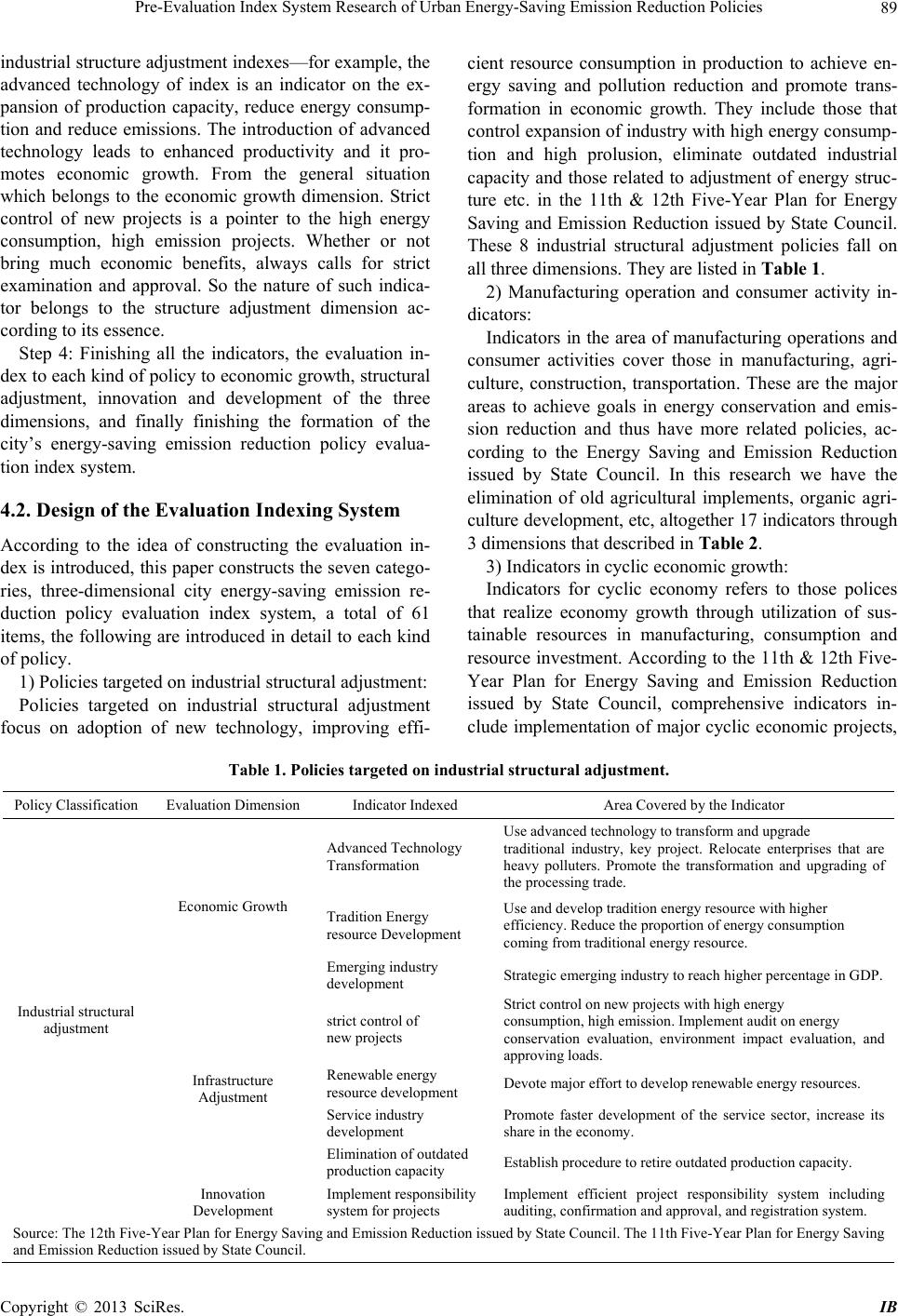 Pre-Evaluation Index System Research of Urban Energy-Saving Emission Reduction Policies Copyright © 2013 SciRes. IB 89 industrial structure adjustment indexes—for example, the advanced technology of index is an indicator on the ex- pansion of production capacity, reduce energy consump- tion and reduce emissions. The introduction of advanced technology leads to enhanced productivity and it pro- motes economic growth. From the general situation which belongs to the economic growth dimension. Strict control of new projects is a pointer to the high energy consumption, high emission projects. Whether or not bring much economic benefits, always calls for strict examination and approval. So the nature of such indica- tor belongs to the structure adjustment dimension ac- cording to its essence. Step 4: Finishing all the indicators, the evaluation in- dex to each kind of policy to economic growth, structural adjustment, innovation and development of the three dimensions, and finally finishing the formation of the city’s energy-saving emission reduction policy evalua- tion index system. 4.2. Design of the Evaluation Indexing System According to the idea of constructing the evaluation in- dex is introduced, this paper constructs the seven catego- ries, three-dimensional city energy-saving emission re- duction policy evaluation index system, a total of 61 items, the following are introd uced in detail to each kind of policy. 1) Policies targeted on industrial structural adjustment: Policies targeted on industrial structural adjustment focus on adoption of new technology, improving effi- cient resource consumption in production to achieve en- ergy saving and pollution reduction and promote trans- formation in economic growth. They include those that control expansion of industry with high energy consump- tion and high prolusion, eliminate outdated industrial capacity and those related to adjustment of energy struc- ture etc. in the 11th & 12th Five-Year Plan for Energy Saving and Emission Reduction issued by State Council. These 8 industrial structural adjustment policies fall on all three dimensions. They are listed in Table 1. 2) Manufacturing operation and consumer activity in- dicators: Indicators in the area of manufacturing operations and consumer activities cover those in manufacturing, agri- culture, construction, transportation. These are the major areas to achieve goals in energy conservation and emis- sion reduction and thus have more related policies, ac- cording to the Energy Saving and Emission Reduction issued by State Council. In this research we have the elimination of old agricultural implements, organic agri- culture development, etc, altogether 17 indicators through 3 dimensions that described in Table 2. 3) Indicators in cyclic economic growth: Indicators for cyclic economy refers to those polices that realize economy growth through utilization of sus- tainable resources in manufacturing, consumption and resource investment. Accord ing to the 11th & 12th Five- Year Plan for Energy Saving and Emission Reduction issued by State Council, comprehensive indicators in- clude implementation of major cyclic economic projects, Table 1. Policies targeted on industrial structural adjustment. Policy Classification Evaluation Dimension Indicator Indexed Area Covered by the Indicator Advanced Technology Transformation Use advanced techno logy to transform and upgrade traditional industry, key project. Relocate enterprises that are heavy polluters. Promote the transformation and upgrading of the processing trade. Tradition Energy resource Development Use and develop tradition energy resource with higher efficiency. Reduce the proportion of energy consumption coming from traditional energy resource. Economic Growt h Emerging industry development Strategic emerging industry to reach higher percentage in GDP. strict control of new projects Strict control on new projects with high energy consumption, high emission. Implement audit on energy conservation evaluation, environment impact evaluation, and approving loads. Renewable energy resource development Devote major ef fort to develop renewable energy resources. Service industry development Promote faster development of the service sector, increase its share in the economy. Infrastructure Adjustment Elimination o f o u td a t e d production capacity Establish procedure to retire outdated production capacity . Industrial structural adjustment Innovation Development Implement responsibility system for projects Implement efficient project responsibility system including auditing, confirmation and approval, and registration system. Source: The 12th Five-Year Plan for E nergy Saving and Emission Reduction issued by State Council. The 11th Five-Year Plan for Energy Saving and Emission Reduction issued by State Council. 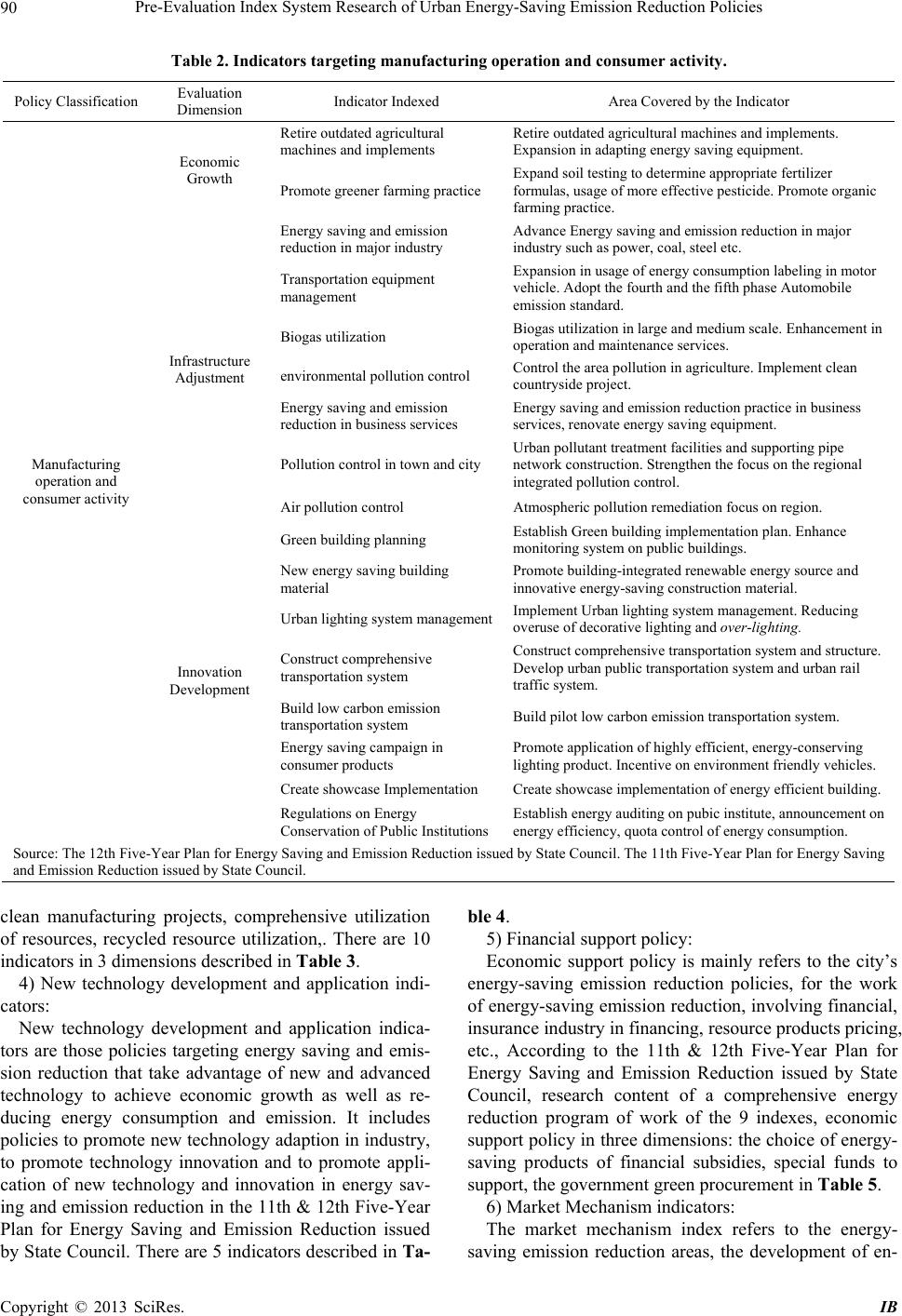 Pre-Evaluation Index System Research of Urban Energy-Saving Emission Reduction Policies 90 Table 2. Indicators targeting manufacturing operation and consumer activity. Policy Classification Evaluation Dimension Indicator I ndexed Area Covered by the Indicator Retire outdated agricultural machines and implements Retire outdated agricultural machines and implements. Expansion in adapting energy saving equipment. Economic Growth Promote greene r farming practice Expand soil testing to determine appropriate fertilizer formulas, usage of more effective pesticide. Promote organic farming pract i c e . Energy saving an d e mission reduction in major industry Advance Energy saving and emission reduction in major industry such as power, coal, steel etc. Transportat ion equipment management Expansion in usage of energy consumption labeling in motor vehicle. Adopt the fourth and the fifth phase Automobile emission standard. Biogas utilization Biogas utilization in large and medium scale. Enhancement in operation and maintenance services. environmental pollution control Control the area pollution in agriculture. Implement clean countryside project. Energy saving an d e mission reduction in business services Energy saving and emission reduction practice in business services, renovate energy saving equipment. Pollution control in town and city Urban pollutant treatment facilities and supporting pipe network construction. Strengthen the focus on the regional integrated pollution control. Infrastructure Adjustment Air pollution control Atmospheric pollution remediation focus on region. Green building planning Establish Green building implementation plan. Enhance monitoring system on public buildings. New energy saving building material Promote building-integrated renewable energy source and innovative energy-saving construction material. Urban lighting syst em managementImplement Urban lighting system management. Reducing overuse of decorative lighting and over-lighting. Construct comprehensive transportation system Construct comprehensive tran sportation system and structure. Develop urban public transportation system and urban rail traffic system. Build low carbon emission transportation system Build pilot low carbon emission transportation system. Energy savi ng campaign in consumer products Promote application of highly efficient, energy-conserving lighting product. Incentive on environment friendly vehicles. Create showcase Implementation Create showcase implementa t ion of energy efficient bui l ding. Manufacturing operation and consumer activity Innovation Development Regulations on Energy Conservation of Public InstitutionsEstablish energy auditing on pubic institute, announcement on energy efficiency, quota control of energy consumption. Source: The 12th Five-Year Plan for Energy Saving and Emission Reduction issued b y State Council. The 11th Five-Year Plan for Energy Saving and Emission Reduction issued by State Council. clean manufacturing projects, comprehensive utilization of resources, recycled resource utilization,. There are 10 indicato rs in 3 dim e n si o ns describe d in Table 3. 4) New technology development and application indi- cators: New technology development and application indica- tors are those policies targeting energy saving and emis- sion reduction that take advantage of new and advanced technology to achieve economic growth as well as re- ducing energy consumption and emission. It includes policies to promote new technology adaption in industry, to promote technology innovation and to promote appli- cation of new technology and innovation in energy sav- ing and emission reduction in the 11th & 12th Five-Year Plan for Energy Saving and Emission Reduction issued by State Council. There are 5 indicators described in Ta- ble 4. 5) Financial support policy: Economic support policy is mainly refers to the city’s energy-saving emission reduction policies, for the work of energy-saving emission reduction, involving financial, insurance industry in financing, resource products pricing, etc., According to the 11th & 12th Five-Year Plan for Energy Saving and Emission Reduction issued by State Council, research content of a comprehensive energy reduction program of work of the 9 indexes, economic support policy in three dimensions: the choice of energy- saving products of financial subsidies, special funds to support, the government green procurement in Table 5. 6) Market Mechanism indicators: The market mechanism index refers to the energy- saving emission reduction areas, the development of en- Copyright © 2013 SciRes. IB 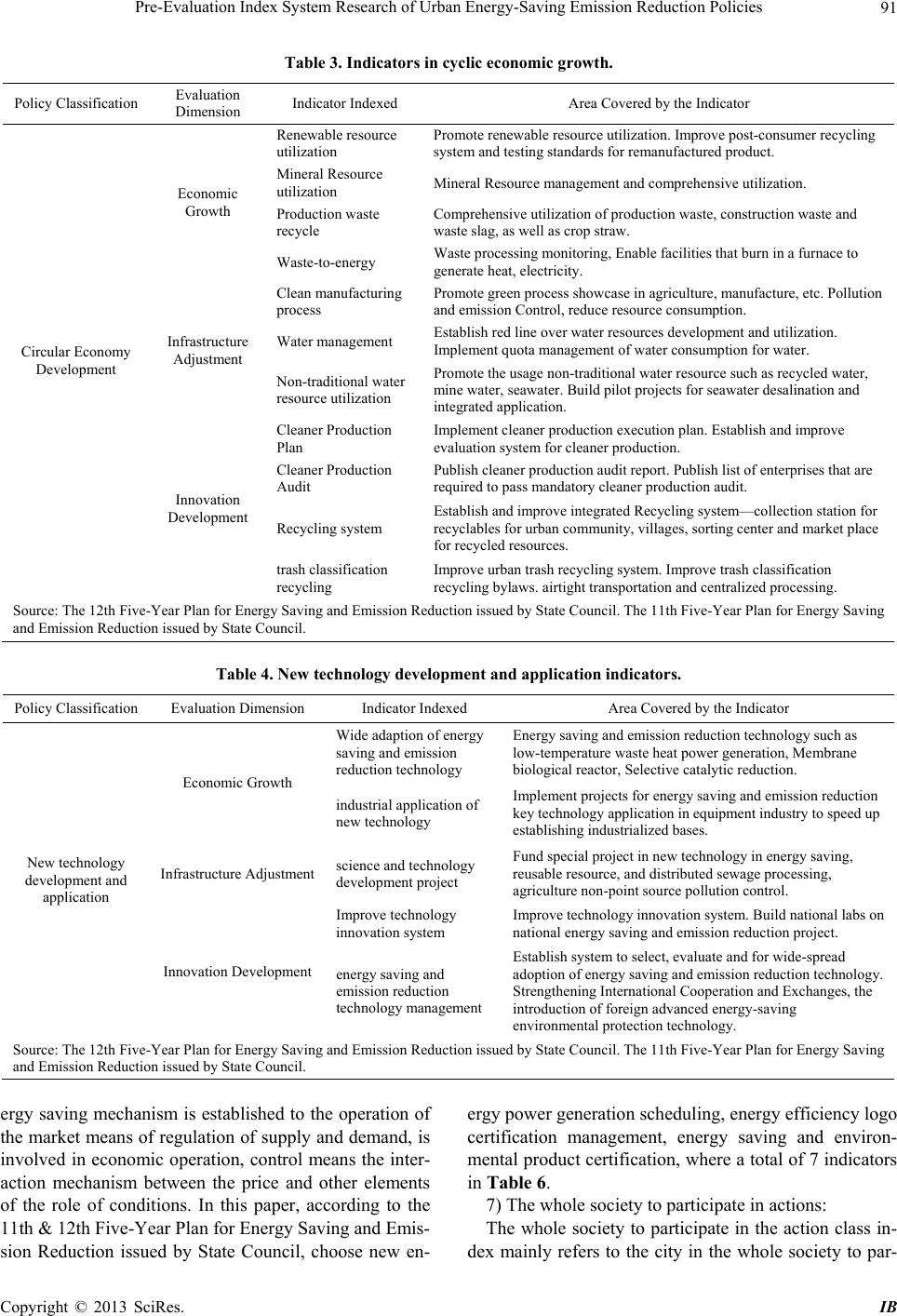 Pre-Evaluation Index System Research of Urban Energy-Saving Emission Reduction Policies 91 Table 3. Indicators in cyclic economic growth. Policy Classification Evaluation Dimension Indicator I ndexed Area Covered by the Indicator Renewable resource utilization Promote renewable resource utilization. Improve post-consumer recycling system and testing standards for remanufactured product. Mineral Resource utilization Mineral Resource management and comprehensive utilization. Production waste recycle Comprehensive utilization of production waste, construction waste and waste slag, as well as crop straw. Economic Growth Waste-to-energy Waste processing monitoring, Enable facilities that burn in a furnace to generate heat, electricity. Clean manufacturing process Promote green process showcase in agriculture, manufacture, etc. Pollution and emission Co n trol, reduce re s ource consumptio n. Water management Establish red line over water resources development and utilization. Implement quo ta management of water consumption for water. Infrastructure Adjustment Non-traditional water resource utilization Promote the usage non-traditional water resource such as recycled water, mine water, seawater. Build pilot projects for seawater desalination and integrated application. Cleaner Production Plan Implement cle aner production execution plan. Establish and improve evaluation system for cleaner production. Cleaner Production Audit Publish cleaner production audit report. Publish list of enterpr ises that are required to pass mandatory cleaner production aud it. Recycling system Establish and improve integrated Recycling system—collection station for recyclables for urban community, villages, sorting center and market place for recycled resources. Circular Economy Development Innovation Development trash classification recycling Improve urban trash recycling system. Improve trash classification recycling bylaws. airtight transportation and centralized processing. Source: The 12th Five-Year Plan for Energy Saving and Emission Reduction issued b y State Council. The 11th Five-Year Plan for Energy Saving and Emission Reduction issued by State Council. Table 4. New technology de velopment and application indicators. Policy Classification Evaluation Dimension Indicator Indexed Area Covered by the Indicator Wide adaption of energy saving and emission reduction technology Energy saving an d e mission reduction technology su ch as low-temperature waste heat power generation, Membrane biological reactor, Selective catalytic reduction. Economic Growt h industrial application of new technology Implement projects for energy saving and emission reduction key technology application in equipme nt industry to speed u p establishing industrialized bases. Infrastructure Adjustment science and technology development project Fund special project in new technology in energy saving, reusable resource, and distributed sewage processing, agriculture non-point source pollution control. Improve technol o g y innovation system Improve tech n o logy innovation system. Build national labs on national energy saving and emission reduction project. New technology development and application Innovation Development energy saving and emission re du c t i o n technology management Establish system to select, evaluate and for wide-spread adoption of energy saving and emission reduction technology. Strengthening International Cooperation and Exchanges, the introduction o f foreign advanc ed energy-saving environmental protection techno logy. Source: The 12th Five-Year Plan for E nergy Saving and Emission Reduction issued by State Council. The 11th Five-Year Plan for Energy Saving and Emission Reduction issued by State Council. ergy saving mechanism is established to the operation of the market means of regulation of supply and demand, is involved in economic operation, control means the inter- action mechanism between the price and other elements of the role of conditions. In this paper, according to the 11th & 12th Five-Year Plan for Energy Saving and Emis- sion Reduction issued by State Council, choose new en- ergy power generation scheduling, energy efficiency logo certification management, energy saving and environ- mental product certification, where a total of 7 indicators in Table 6. 7) The whole society to participate in actions: The whole society to participate in the action class in- dex mainly refers to the city in the whole society to par- Copyright © 2013 SciRes. IB 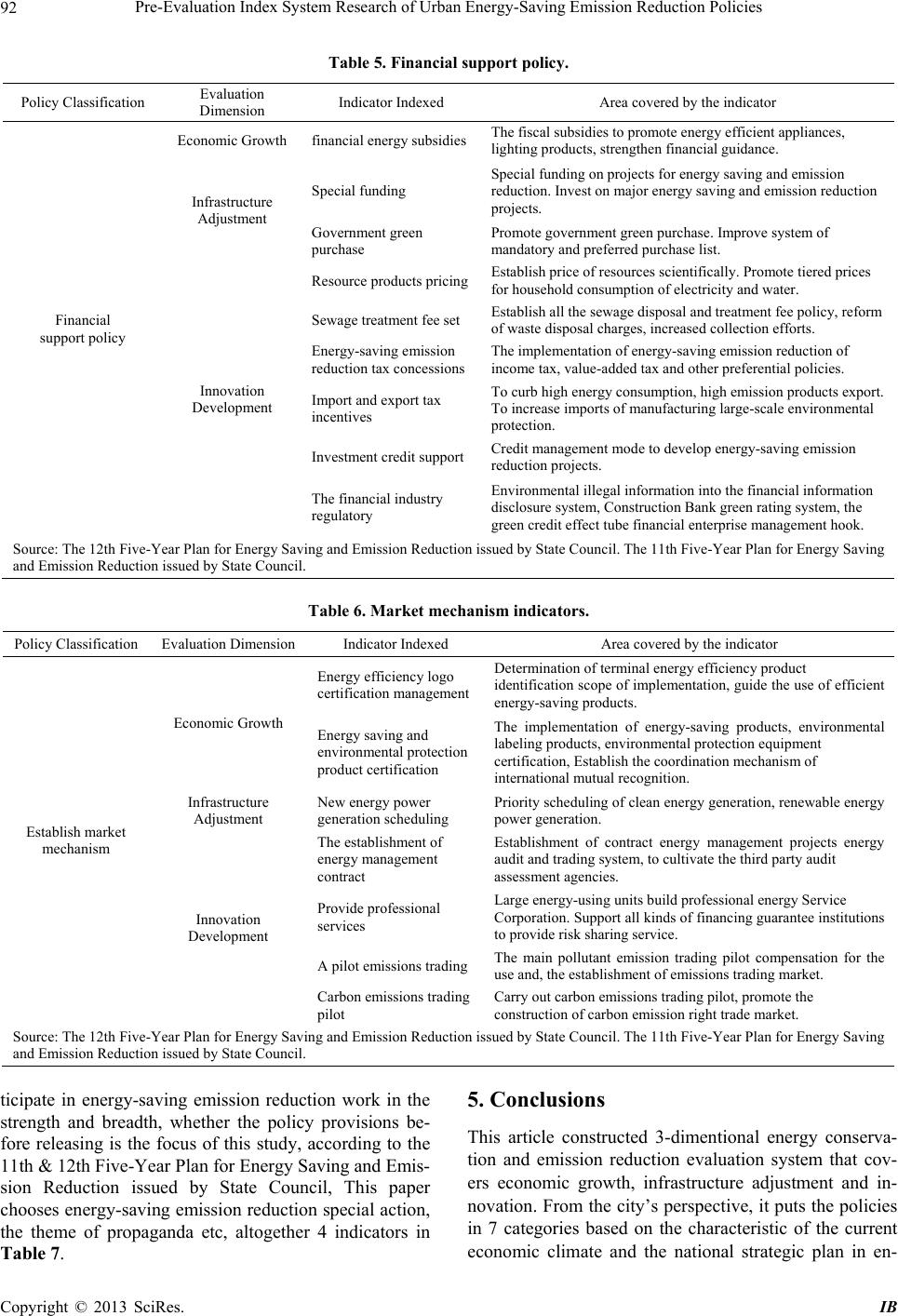 Pre-Evaluation Index System Research of Urban Energy-Saving Emission Reduction Policies 92 Table 5. Financial support policy. Policy Classification Evaluation Dimension Indicator Indexed Area covered by the indicator Economic Growth financial energy subsidiesThe fiscal subsidies to promote energy efficient appliances, lighting products, strengthen financial guidance. Special funding Special funding on projects for energy saving and emission reduction. Inves t on major energy saving and emission reduction projects. Infrastructure Adjustment Government green purchase Promote government green purcha se. Improve syste m of mandatory and preferred purchase li s t . Resource products pricingEstablish price of resources scientifically. Promote tiered prices for household c onsumption of electricity and water. Sewage treatment fee set Establish all the sewage disposal and treatment fee policy, reform of waste disposal charges, increased collection efforts. Energy-sa v i ng emission reduction tax concessions The implementation of ene rgy-saving emission reducti on of income tax, value-added tax and other preferential policies. Import and export tax incentives To curb high ener gy consumption , high emission products export. To increase imports of manufacturing large-scale environmental protection. Investment credit support Credit management mode to develop energy-savi ng emission reduction projects. Financial support policy Innovation Development The financial industry regulatory Environmental illegal information into the financial information disclosure syst e m, Construction Bank green rating syst em, the green credit effect tube financial enterprise management hook. Source: The 12th Five-Year Plan for E nergy Saving and Emission Reduction issued by State Council. The 11th Five-Year Plan for Energy Saving and Emission Reduction issued by State Council. Table 6. Market mechanism indicators. Policy Classification Evaluation Dimension Indicator Indexed Area covered by the indicator Energy efficiency logo certification management Determination of terminal energy efficiency product identification scope of implementation, guide the use of efficient energy-saving products. Economic Growt h Energy saving and environmental protection product certification The implementation of energy-saving products, environmental labeling products, environmental protection eq u ipment certification, Establish the coordination mechanism of international mutual recognition. Infrastructure Adjustment New energy power generation scheduling Priority scheduling of clean energy generation, renewable energy power generation. The establishment of energy management contract Establishment of contract energy management projects energy audit and trading system, to cultivate the third party audit assessment agencies. Provide professional services Large energy-using units build professional energy Service Corporation. Support all kinds of financing guarantee institutions to provide risk sharing service. A pilot emissions trading The main pollutant emission trading pilot compensation for the use and, the establishment of emissions trading market. Establish market mechanism Innovation Development Carbon emiss i o ns trading pilot Carry out carbon emissions trad i ng pilot, promote the construction of carbon emission right trade market. Source: The 12th Five-Year Plan for E nergy Saving and Emission Reduction issued by State Council. The 11th Five-Year Plan for Energy Saving and Emission Reduction issued by State Council. ticipate in energy-saving emission reduction work in the strength and breadth, whether the policy provisions be- fore releasing is the focus of this study, according to the 11th & 12th Five-Year Plan for Energy Saving and Emis- sion Reduction issued by State Council, This paper chooses energy-sav ing emission reduction special action, the theme of propaganda etc, altogether 4 indicators in Table 7. 5. Conclusions This article constructed 3-dimentional energy conserva- tion and emission reduction evaluation system that cov- ers economic growth, infrastructure adjustment and in- novation. From the city’s perspective, it puts the policies in 7 categories based on the characteristic of the current economic climate and the national strategic plan in en- Copyright © 2013 SciRes. IB 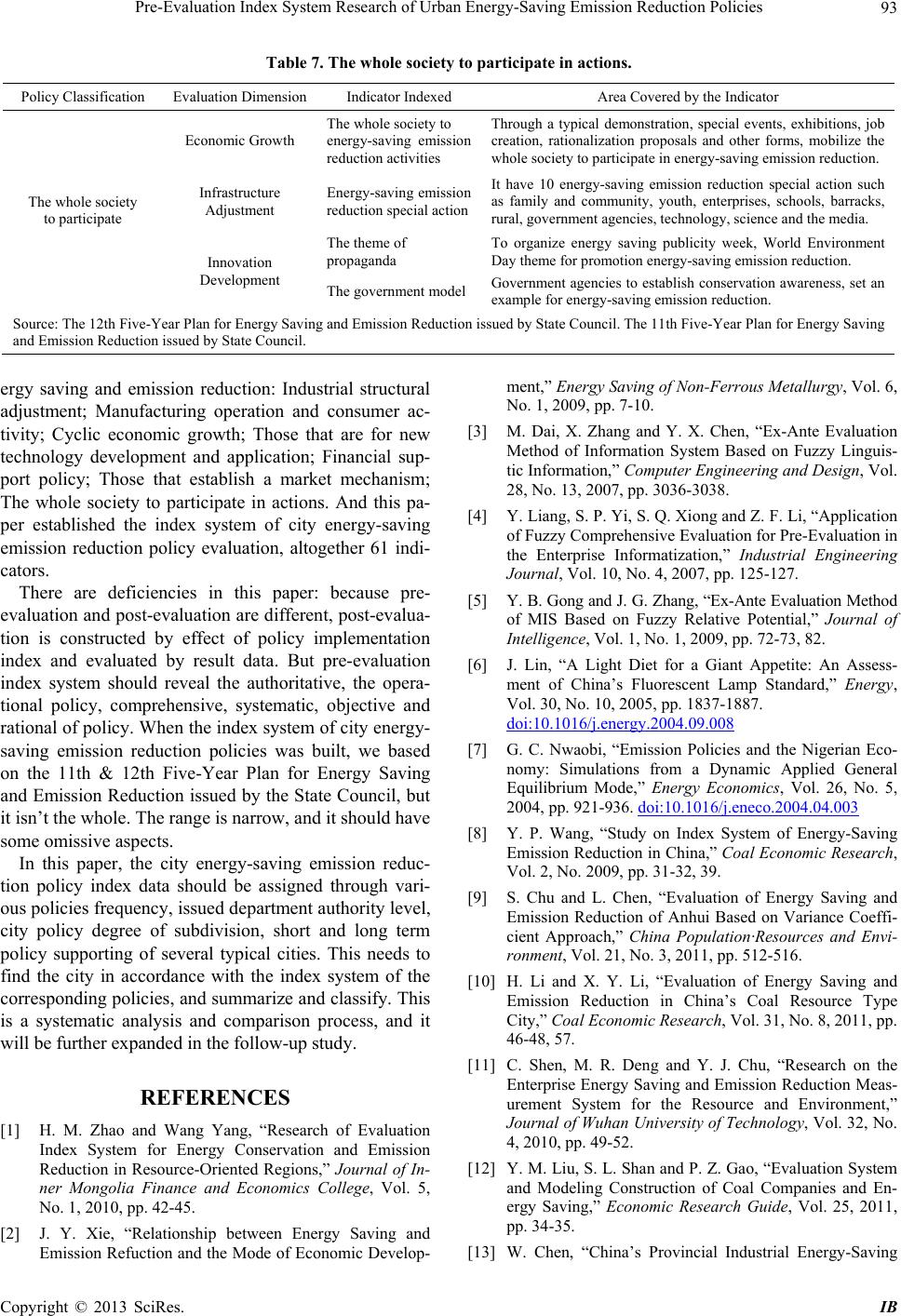 Pre-Evaluation Index System Research of Urban Energy-Saving Emission Reduction Policies 93 Table 7. The whole society to participate in actions. Policy Classification Evaluation Dimension Indicator Indexed Area Covered by the Indicator Economic Growt h The whole society to energy-saving emission reduction activities Through a typical demonstration, special events, exhibitions, job creation, rationalization proposals and other forms, mobilize the whole society to participate in energy-saving emission reduction. Infrastructure Adjustment Energy-saving emission reduction special action It have 10 energy-saving emission reduction special action such as family and community, youth, enterprises, schools, barracks, rural, government agencies, technology, science and the media. The theme of propaganda To organize energy saving publicity week, World Environment Day theme for promotion energy-saving emission reduction. The whole society to participate Innovation Development The government model Government agencies to establish conservation awareness, set an example for energy-saving emission reduction. Source: The 12th Five-Year Plan for E nergy Saving and Emission Reduction issued by State Council. The 11th Five-Year Plan for Energy Saving and Emission Reduction issued by State Council. ergy saving and emission reduction: Industrial structural adjustment; Manufacturing operation and consumer ac- tivity; Cyclic economic growth; Those that are for new technology development and application; Financial sup- port policy; Those that establish a market mechanism; The whole society to participate in actions. And this pa- per established the index system of city energy-saving emission reduction policy evaluation, altogether 61 indi- cators. There are deficiencies in this paper: because pre- evaluation and post-evaluation are different, post-evalua- tion is constructed by effect of policy implementation index and evaluated by result data. But pre-evaluation index system should reveal the authoritative, the opera- tional policy, comprehensive, systematic, objective and rational of policy. When the index system of city energy- saving emission reduction policies was built, we based on the 11th & 12th Five-Year Plan for Energy Saving and Emission Reduction issued by the State Council, but it isn’t the whole. The range is narrow, and it should have some omissive aspects. In this paper, the city energy-saving emission reduc- tion policy index data should be assigned through vari- ous policies frequency, issued department authority level, city policy degree of subdivision, short and long term policy supporting of several typical cities. This needs to find the city in accordance with the index system of the corresponding policies, and summarize and classify. This is a systematic analysis and comparison process, and it will be further expanded in the follow-up study. REFERENCES [1] H. M. Zhao and Wang Yang, “Research of Evaluation Index System for Energy Conservation and Emission Reduction in Resource-Oriented Regions,” Journal of In- ner Mongolia Finance and Economics College, Vol. 5, No. 1, 2010, pp. 42-45. [2] J. Y. Xie, “Relationship between Energy Saving and Emission Refuction and the Mode of Economic Develop- ment,” Energy Saving of Non-Ferrous Metallurgy, Vol. 6, No. 1, 2009, pp. 7-10. [3] M. Dai, X. Zhang and Y. X. Chen, “Ex-Ante Evaluation Method of Information System Based on Fuzzy Linguis- tic Information,” Computer Engineering and Design, Vol. 28, No. 13, 2007, pp. 3036-3038. [4] Y. Liang, S. P. Yi, S. Q. Xiong and Z. F. Li, “Application of Fuzzy Comprehensive Evaluation for Pre-Evaluation in the Enterprise Informatization,” Industrial Engineering Journal, Vol. 10, No. 4, 2007, pp. 125-127. [5] Y. B. Gong and J. G. Zhang, “Ex-Ante Evaluation Method of MIS Based on Fuzzy Relative Potential,” Journal of Intelligence, Vol. 1, No. 1, 2009, pp. 72-73, 82. [6] J. Lin, “A Light Diet for a Giant Appetite: An Assess- ment of China’s Fluorescent Lamp Standard,” Energy, Vol. 30, No. 10, 2005, pp. 1837-1887. doi:10.1016/j.energy.2004.09.008 [7] G. C. Nwaobi, “Emission Policies and the Nigerian Eco- nomy: Simulations from a Dynamic Applied General Equilibrium Mode,” Energy Economics, Vol. 26, No. 5, 2004, pp. 921-936. doi:10.1016/j.eneco.2004.04.003 [8] Y. P. Wang, “Study on Index System of Energy-Saving Emission Reduction in China,” Coal Economic Research, Vol. 2, No. 2009, pp. 31-32, 39. [9] S. Chu and L. Chen, “Evaluation of Energy Saving and Emission Reduction of Anhui Based on Variance Coeffi- cient Approach,” China Population·Resources and Envi- ronment, Vol. 21, No. 3, 2011, pp. 512-516. [10] H. Li and X. Y. Li, “Evaluation of Energy Saving and Emission Reduction in China’s Coal Resource Type City,” Coal Economic Research, Vol. 31, No. 8, 2011, pp. 46-48, 57. [11] C. Shen, M. R. Deng and Y. J. Chu, “Research on the Enterprise Energy Saving and Emission Reduction Meas- urement System for the Resource and Environment,” Journal of Wuhan University of Technology, Vol. 32, No. 4, 2010, pp. 49-52. [12] Y. M. Liu, S. L. Shan and P. Z. Gao, “Evaluation System and Modeling Construction of Coal Companies and En- ergy Saving,” Economic Research Guide, Vol. 25, 2011, pp. 34-35. [13] W. Chen, “China’s Provincial Industrial Energy-Saving Copyright © 2013 SciRes. IB 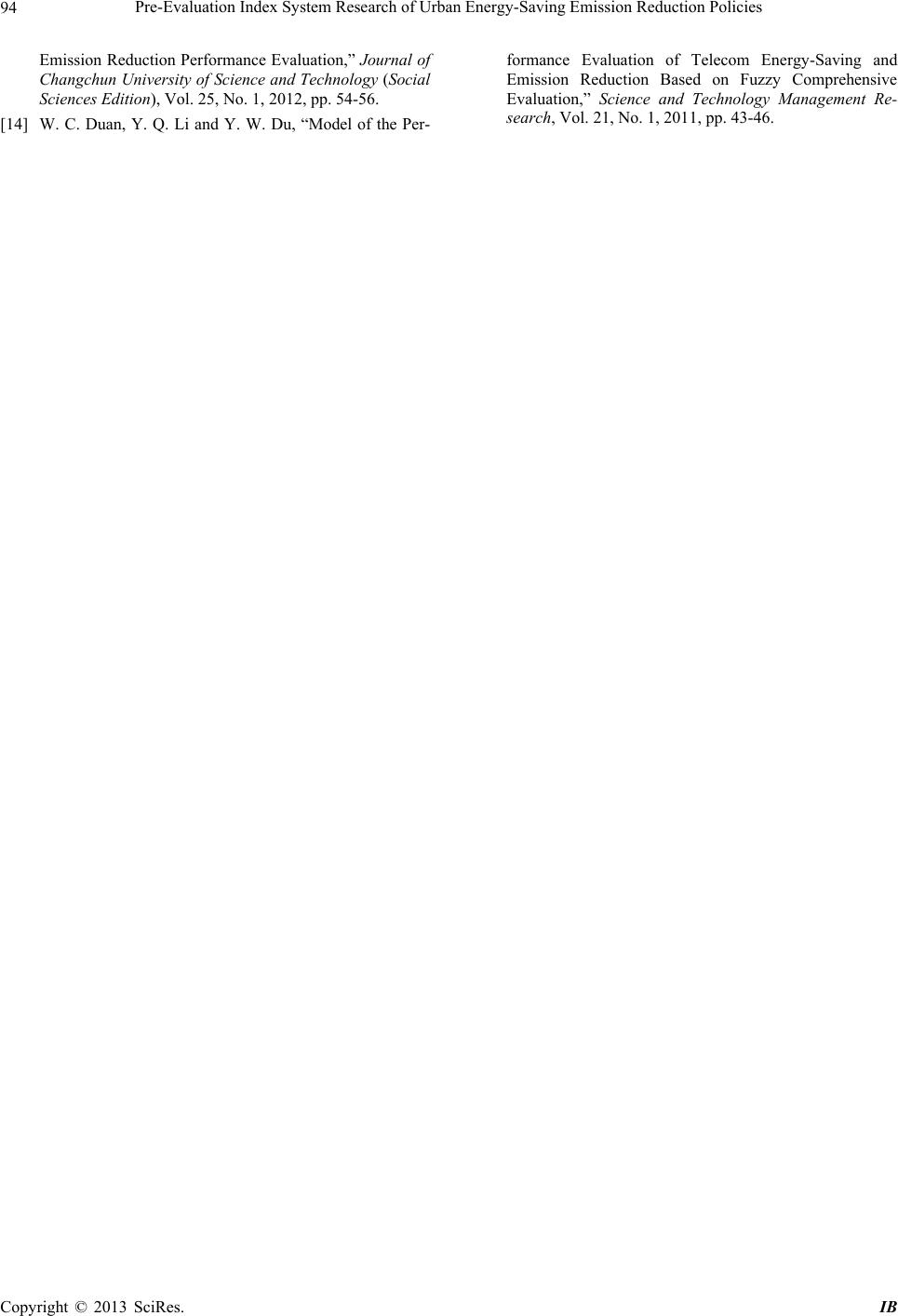 Pre-Evaluation Index System Research of Urban Energy-Saving Emission Reduction Policies 94 Emission Reduction Performance Evaluation,” Journal of Changchun University of Science and Technology (Social Sciences Ed i tion), Vol. 25, No. 1, 2012, pp. 54-56. [14] W. C. Duan, Y. Q. Li and Y. W. Du, “Model of the Per- formance Evaluation of Telecom Energy-Saving and Emission Reduction Based on Fuzzy Comprehensive Evaluation,” Science and Technology Management Re- search, Vol. 21, No. 1, 2011, pp. 43-46. Copyright © 2013 SciRes. IB
|